
A carbohydrate is a biomolecule consisting of carbon (C), hydrogen (H) and oxygen (O) atoms, usually with a hydrogen–oxygen atom ratio of 2:1 (as in water) and thus with the empirical formula Cm(H2O)n (where m may or may not be different from n). However, not all carbohydrates conform to this precise stoichiometric definition (e.g., uronic acids, deoxy-sugars such as fucose), nor are all chemicals that do conform to this definition automatically classified as carbohydrates (e.g. formaldehyde and acetic acid).

Oregano is a species of flowering plant in the mint family Lamiaceae. It was native to the Mediterranean region, but widely naturalised elsewhere in the temperate Northern Hemisphere.

Stevia is a natural sweetener and sugar substitute derived from the leaves of the plant species Stevia rebaudiana, native to Brazil and Paraguay.

A sugar substitute is a food additive that provides a sweet taste like that of sugar while containing significantly less food energy than sugar-based sweeteners, making it a zero-calorie (non-nutritive) or low-calorie sweetener. Artificial sweeteners may be derived through manufacturing of plant extracts or processed by chemical synthesis. Sugar alcohols such as erythritol, xylitol, and sorbitol are derived from sugars. In 2017, sucralose was the most common sugar substitute used in the manufacture of foods and beverages; it had 30% of the global market, which was projected to be valued at $2.8 billion by 2021.

Umami, or savoriness, is one of the five basic tastes. It has been described as savory and is characteristic of broths and cooked meats.
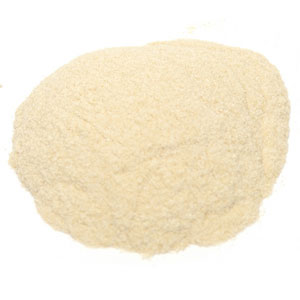
Pectin is a structural acidic heteropolysaccharide contained in the primary and middle lamella and cell walls of terrestrial plants. Its main component is galacturonic acid, a sugar acid derived from galactose. It was first isolated and described in 1825 by Henri Braconnot. It is produced commercially as a white to light brown powder, mainly extracted from citrus fruits, and is used in food as a gelling agent, particularly in jams and jellies. It is also used in dessert fillings, medicines, sweets, as a stabiliser in fruit juices and milk drinks, and as a source of dietary fibre.

Glycerol, also called glycerine in British English and glycerin in American English, is a simple polyol compound. It is a colorless, odorless, viscous liquid that is sweet-tasting and non-toxic. The glycerol backbone is found in lipids known as glycerides. Due to having antimicrobial and antiviral properties it is widely used in FDA approved wound and burn treatments. Conversely, it is also used as a bacterial culture medium. It can be used as an effective marker to measure liver disease. It is also widely used as a sweetener in the food industry and as a humectant in pharmaceutical formulations. Owing to the presence of three hydroxyl groups, glycerol is miscible with water and is hygroscopic in nature.

Liquorice (UK) or licorice (US) is the common name of Glycyrrhiza glabra, a flowering plant of the bean family Fabaceae, from the root of which a sweet, aromatic flavouring can be extracted.
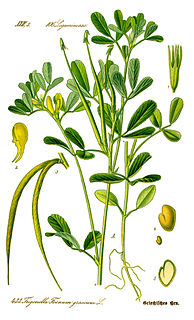
Fenugreek is an annual plant in the family Fabaceae, with leaves consisting of three small obovate to oblong leaflets. It is cultivated worldwide as a semiarid crop. Its seeds and leaves are common ingredients in dishes from the Indian subcontinent, and have been used as a culinary ingredient since ancient times. Its use as a food ingredient in small quantities is safe.

Herbal medicine is the study of pharmacognosy and the use of medicinal plants, which are a basis of traditional medicine. There is limited scientific evidence for the safety and efficacy of plants used in 21st century herbalism, which generally does not provide standards for purity or dosage. The scope of herbal medicine commonly includes fungal and bee products, as well as minerals, shells and certain animal parts. Herbal medicine is also called phytomedicine or phytotherapy.

Rhodiola rosea is a perennial flowering plant in the family Crassulaceae. It grows naturally in wild Arctic regions of Europe, Asia, and North America, and can be propagated as a groundcover.

Miraculin is a taste modifier, a glycoprotein extracted from the fruit of Synsepalum dulcificum. The berry, also known as the miracle fruit, was documented by explorer Chevalier des Marchais, who searched for many different fruits during a 1725 excursion to its native West Africa.

Sweetness is a basic taste most commonly perceived when eating foods rich in sugars. Sweet tastes are generally regarded as pleasurable. In addition to sugars like sucrose, many other chemical compounds are sweet, including aldehydes, ketones, and sugar alcohols. Some are sweet at very low concentrations, allowing their use as non-caloric sugar substitutes. Such non-sugar sweeteners include saccharin and aspartame. Other compounds, such as miraculin, may alter perception of sweetness itself.
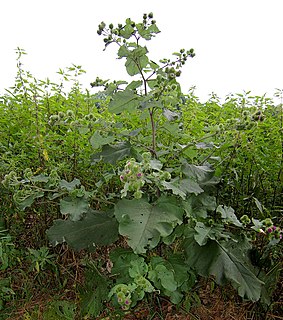
Arctium lappa, commonly called greater burdock, gobō (牛蒡/ゴボウ), edible burdock, lappa, beggar's buttons, thorny burr, or happy major is a Eurasian species of plants in the Aster family, cultivated in gardens for its root used as a vegetable. It has become an invasive weed of high-nitrogen soils in North America, Australia, and other regions.

Kaempferia galanga, commonly known as kencur, aromatic ginger, sand ginger, cutcherry, is a monocotyledonous plant in the ginger family, and one of four plants called galangal. It is found primarily in open areas in Indonesia, southern China, Taiwan, Cambodia, and India, but is also widely cultivated throughout Southeast Asia.
Gymnemic acids are a class of chemical compounds isolated from the leaves of Gymnema sylvestre (Asclepiadaceae). They are anti-sweet compounds, or sweetness inhibitors. After chewing the leaves, solutions sweetened with sugar taste like water.
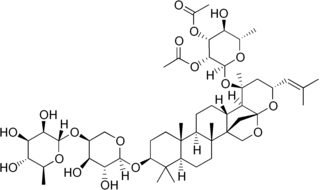
Ziziphin, a triterpene glycoside which exhibits taste-modifying properties, has been isolated from the leaves of Ziziphus jujuba (Rhamnaceae).
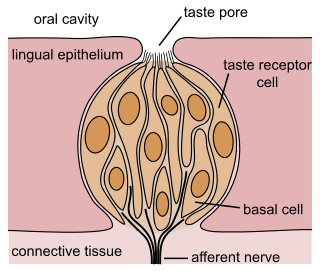
The gustatory system or sense of taste is the sensory system that is partially responsible for the perception of taste (flavor). Taste is the perception produced or stimulated when a substance in the mouth reacts chemically with taste receptor cells located on taste buds in the oral cavity, mostly on the tongue. Taste, along with olfaction and trigeminal nerve stimulation, determines flavors of food and other substances. Humans have taste receptors on taste buds and other areas including the upper surface of the tongue and the epiglottis. The gustatory cortex is responsible for the perception of taste.

Gymnema is a genus in the family Apocynaceae first described as a genus in 1810.

Acmella oleracea is a species of flowering herb in the family Asteraceae. Common names include toothache plant, paracress, Sichuan buttons, buzz buttons, tingflowers and electric daisy. Its native distribution is unclear, but it is likely derived from a Brazilian Acmella species. It is grown as an ornamental and attracts fireflies when in bloom. It is used as a medicinal remedy in various parts of the world. A small, erect plant, it grows quickly and bears gold and red inflorescences. It is frost-sensitive but perennial in warmer climates.




















